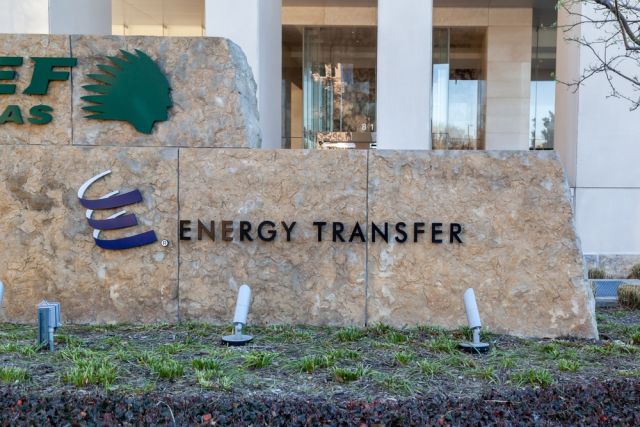
Energy Transfer headquarters in Dallas, Texas. (Source: Shutterstock)
Energy Transfer set transport records over its pipeline network in the third quarter, and company leaders told investors during an earnings call that they expect the growth to keep coming, especially after the Exxon Mobil acquisition of Pioneer Natural Resources.
Compared to the same quarter last year, Energy Transfer saw record growth in all things NGL: fractionation volumes were up 9%, transportation volumes increased 14% and exports grew more than 20%. Energy Transfer set company records in each category.
Crude transportation also rose by 23% and terminal volumes by 15%, also setting company records.
Most of the extra production, executives said, has come from expanded scale in Energy Transfer’s network in the Permian Basin with the merger of Lotus Midstream Operations. The $1.45 billion acquisition added 3,000 miles of crude oil pipelines.
Financially, Energy Transfer reported third-quarter EBITDA of $3.5 billion, compared to $3.1 billion year-over-year.
The company’s focus remains on the Permian. Midstream companies with a large base in the area, including Energy Transfer, are watching for developments following Exxon Mobil’s acquisition of Pioneer. Energy Transfer executives believe the move will benefit the company.
“You look at the consolidation that’s going on upstream, a lot of that, of course, is around the bigger deals in the Permian Basin,” co-CEO Mackie McCrea said. “Nobody is better positioned to capitalize on that than Energy Transfer—from every standpoint, from gathering, processing, NGL takeaway, intra-interstate pipeline takeaway, crude takeaway.”
At the time the Exxon deal was announced in early October, analysts were mixed on the repercussions for midstream providers. The company may look to shut down facilities that duplicate efforts, causing the potential number of pipeline miles in use to decline, according to East Daley Analytics, which rated Energy Transfer and Targa Resources as the companies facing the most risk. However, midstream operators could see an overall boost if Exxon Mobil decides to increase production enough to overcome possible facility shutdowns.
McCrea said he was confident that the production growth would continue.
“What an incredible area of the world that we've heavily invested in, and we see it paying off for many years to come,” he said.
Scaling up
Energy Transfer can expect a bump in volume starting next month, as the company’s merger with Crestwood Equity Partners closed on Nov. 3.
Crestwood’s assets add 1.1 Bcf/d of natural gas gathering capacity in the Delaware Basin and another 818 MMcf/d combined natural gas gathering capacity in the Powder River and Williston basins. Energy Transfer co-CEO Tom Long said the assets are expected to strengthen Energy Transfer’s downstream fractionation capacity at Mont Belvieu, Texas, along with its hydrocarbon export operation at the Nederland terminal in Texas and Marcus Hook terminal in Pennsylvania.
“We haven't been able to really dig into the Crestwood assets yet,” McCrea said. “But from a high level, we certainly recognize some capacities.”
The Nederland Terminal will receive an expansion expected to cost $1.25 billion and is scheduled to go online by the middle of 2025. Improvements will focus on the facility’s NGL export system that is expected to add about 250,000 bbl/d to its current 700,000 bbl/d of capacity. Growth in international demand for NGLs is being driven by Asia and especially China.
“It’s hard to overexaggerate the ethane and, more importantly, the LPG growth,” McCrea said. “Assets cannot be built quick enough in the U.S. to meet the international demand.”
Executives also updated investors on the status of the permitting process that has held up a future export operation in Lake Charles, Louisiana.
The Lake Charles project would create a large-scale export facility on the Calcasieu Ship Channel. The plan is to convert Energy Transfer’s current Lake Charles LNG import terminal to an export facility. The project allows Energy Transfer to take advantage of an abundant natural gas supply and its proximity to significant pipeline infrastructure in the area.
In the summer of 2022, the Federal Energy Regulatory Commission approved an extension on the completion of the project to December 2028. Energy Transfer followed that with an application to the Department of Energy (DOE) for a deadline extension to commence exports. In April, the request was denied. In June, the department rejected the request for a rehearing of the denial.
“We really need to get the DOE to extend the permit,” said McCrea. “A lot of folks (are) involved behind the scenes trying to make that happen, including other countries, other businesses in other countries, but we're just keeping our head down, pushing. We don't really have a lot of estimates.”
The company is hopeful that the DOE will issue a ruling sometime in the first quarter of next year, he said.
Recommended Reading
Enbridge Advances Expansion of Permian’s Gray Oak Pipeline
2024-02-13 - In its fourth-quarter earnings call, Enbridge also said the Mainline pipeline system tolling agreement is awaiting regulatory approval from a Canadian regulatory agency.
Moda Midstream II Receives Financial Commitment for Next Round of Development
2024-03-20 - Kingwood, Texas-based Moda Midstream II announced on March 20 that it received an equity commitment from EnCap Flatrock Midstream.
Oil and Gas Chain Reaction: E&P M&A Begets OFS Consolidation
2024-04-26 - Record-breaking E&P consolidation is rippling into oilfield services, with much more M&A on the way.
Range Resources Holds Production Steady in 1Q 2024
2024-04-24 - NGLs are providing a boost for Range Resources as the company waits for natural gas demand to rebound.
Sunoco’s $7B Acquisition of NuStar Evades Further FTC Scrutiny
2024-04-09 - The waiting period under the Hart-Scott-Rodino Antitrust Improvements Act for Sunoco’s pending acquisition of NuStar Energy has expired, bringing the deal one step closer to completion.





